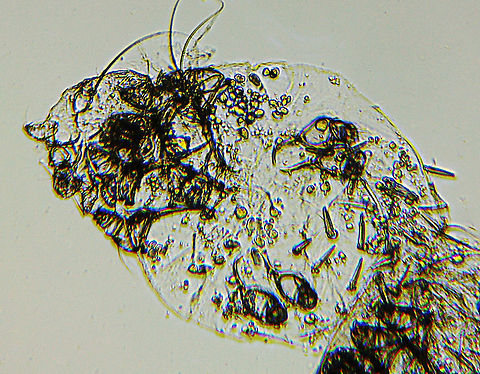
Appearance
Adult scabies mites are spherical, eyeless mites with four pairs of legs. They are recognizable by their oval, ventrally flattened and dorsally convex tortoise-like bodies and multiple cuticular spines. No demarcation into cephalothorax or abdomen occurs, and the mite's surface has folds covered with short bristles. The front legs end in long, tubular processes known as suckers, and the hind legs end in long bristles. The male has suckers on all legs except the third pair, which distinguishes it from the female. Females are 0.3–0.45 mm long and 0.25–0.35 mm wide, and males are just over half that size.Behavior
The scabies mite ''Sarcoptes scabiei'' var. ''hominis'' goes through four stages in its lifecycle: egg, larva, nymph, and adult.Upon infesting a human host, the adult female burrows into the ''stratum corneum'' , where she deposits two or three eggs per day. These oval eggs are 0.1–0.15 mm long and hatch as larvae in three to four days. A female can lay up to 30 eggs, then dies at the end of a burrow. Upon hatching, the six-legged larvae migrate to the skin surface and then burrow into molting pouches, usually into hair follicles, where vesicles form . After three to four days, the larvae molt, turning into eight-legged nymphs. This form molts a second time into slightly larger nymphs, before a final molt into adult mites. Adult mites then mate when the male penetrates the molting pouch of the female. Mating occurs only once, as that one event leaves the female fertile for the rest of her life . The impregnated female then leaves the molting pouch in search of a suitable location for a permanent burrow. Once a site is found, the female creates her characteristic S-shaped burrow, laying eggs in the process. The female will continue lengthening her burrow and laying eggs for the duration of her life.
References:
Some text fragments are auto parsed from Wikipedia.